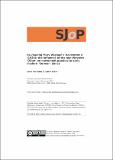Files in this item
Re-reading Mary Wigman's Hexentanz II (1926): the influence of the non-Western 'Other' on movement practice in early modern 'German' dance
Item metadata
| dc.contributor.author | Tsitsou, Lito | |
| dc.contributor.author | Weir, Lucy | |
| dc.coverage.spatial | 22 | en_US |
| dc.date.accessioned | 2014-10-03T16:05:53Z | |
| dc.date.available | 2014-10-03T16:05:53Z | |
| dc.date.issued | 2013-12 | |
| dc.identifier.citation | Tsitsou, L. and Weir, L. (2013). Re-reading Mary Wigman’s Hexentanz II (1926): the influence of the non-Western ‘Other’ on movement practice in early modern ‘German’ dance. Scottish Journal of Performance, 1(1), pp. 53–74. | en_US |
| dc.identifier.issn | 2054-1961 | en_US |
| dc.identifier.uri | https://hdl.handle.net/10023/5528 | |
| dc.description.abstract | This paper provides a re-reading of Mary Wigman’s Hexentanz II (‘Witch Dance’, 1926), emphasising the social and aesthetic conditions in which she created dance works. A renewed interest in the idea of a return to nature characterised the artistic mood of this period, and scholars conceive of this return as an antidote to the capitalist modernisation of Germany and the effects of the First World War. This paper views Wigman’s work as a prominent example of the reversion to ‘primitive’ forms as a means of devising a new, avant-garde creative practice. The witch’s dance indicates a return to ‘primitive ritualism’, which is linked to the construction of the non-Western ‘Other’ as authentic and pure. Hexentanz II drew on various non-Western cultural elements, which became crystallised into a new technique and style of movement. However, as Edward Said (1978) would argue, such cultural elements are utilised for the benefit of the West and the construction of a modern dance more widely, a fraction of which would be gradually fabricated as ‘German’. | en_US |
| dc.language.iso | en | en_US |
| dc.publisher | The Royal Conservatoire of Scotland | en_US |
| dc.relation.ispartof | Scottish Journal of Performance | en_US |
| dc.rights | This work is licensed under a Creative Commons Attribution 4.0 International License. | en_US |
| dc.rights.uri | http://creativecommons.org/licenses/by/4.0/ | |
| dc.subject | Historical sociology of dance | en_US |
| dc.subject | Mary Wigman | en_US |
| dc.subject | Hexentanz II | en_US |
| dc.subject.lcc | PN1576 | en_US |
| dc.subject.lcsh | Performing arts--Research | en_US |
| dc.subject.lcsh | Dance--Research | en |
| dc.subject.lcsh | Performing arts--Research--Germany | en |
| dc.title | Re-reading Mary Wigman's Hexentanz II (1926): the influence of the non-Western 'Other' on movement practice in early modern 'German' dance | en_US |
| dc.type | Journal article | en_US |
| dc.description.version | Publisher PDF | en_US |
| dc.publicationstatus | Published | en_US |
| dc.status | Peer reviewed | en_US |
| dc.identifier.doi | https://doi.org/10.14439/sjop.2013.0101.04 | en |
This item appears in the following Collection(s)
Except where otherwise noted within the work, this item's licence for re-use is described as This work is licensed under a Creative Commons Attribution 4.0 International License.
Items in the St Andrews Research Repository are protected by copyright, with all rights reserved, unless otherwise indicated.


